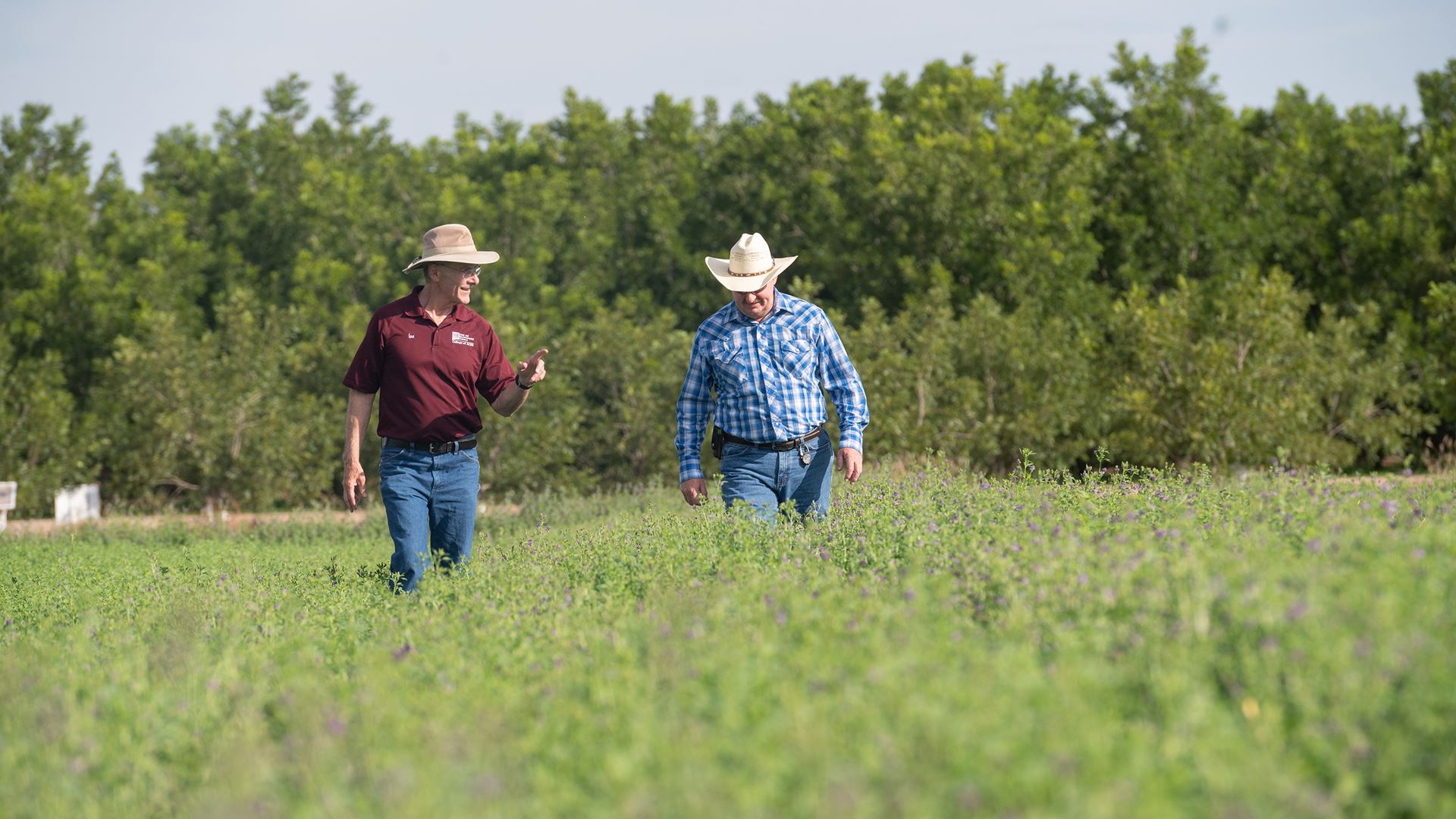Las Cruces, New Mexico, USA
November 12, 2024

Ian Ray, left, and Christopher Pierce have collaborated on alfalfa research at New Mexico State University for several years. Ray’s research team will release three drought-tolerant varieties over the next year, potentially benefiting the $12 billion alfalfa industry in the United States. (NMSU photo by Josh Bachman)
A breeze wafted through the air on a late summer morning, rustling neatly kept plots of lush-green alfalfa at New Mexico State University’s Leyendecker Plant Science Research Center. The field had all the signs of a well-maintained crop of forage. But its neighboring field was an entirely different story.
A short distance away, withering alfalfa remnants, unlike their vibrant, purple-flowering counterparts, dotted a square acre of dry and cracked soil. Here, NMSU researchers are testing multiple varieties of drought-resilient alfalfa developed over 25 years, using molecular techniques and conventional breeding approaches.
“The fields are growing the same alfalfa but look completely different,” said Ian Ray, an emeritus professor of agronomy at NMSU who headed the project.
The stark contrast between the two fields is the result of growing the varieties under well-watered and water-deficit conditions. Researchers regularly watered one field and harvested it seven times from March to November. Meanwhile, they only irrigated the other field from March to June and harvested it three times during spring. That meant, by late July, very little forage growth was present in the water-deficit field.
“Based on one stress cycle of early irrigation termination, from July 2023 to February 2024,” Ray said, “our research shows that many of our new varieties can survive eight months without regular watering and still produce economical yields the following year once they are irrigated again.”
The results suggest that if growers have limited irrigation, they can potentially apply their full water allotment in the spring to maximize alfalfa yield. Then, they may be able to terminate irrigation for the remainder of the growing season without killing the alfalfa.
Ray’s team will release three drought-tolerant varieties over the next year, potentially benefiting the $12 billion alfalfa industry a time when water resources continue to diminish across much of the Great Plains and western U.S.
Whether used in irrigated pastures or as hay, alfalfa is one of the most economically important crops in the nation, feeding the $50 billion livestock industry and contributing to sales of meat, dairy and other livestock-generated products.
In New Mexico, Alfalfa is often the No. 1 forage crop and competes with pecans as the state’s top cash crop. In 2023, New Mexico had 145,000 acres of alfalfa in production, a 22,000-acre increase from the previous year. At an average of $304 per ton, estimated gross returns from alfalfa hay produced in 2023 totaled more than $238 million.
NMSU has been a leader in advancing alfalfa drought-tolerance research since the 1940s.
Ray began his work in 1994 when he joined NMSU to head the forage breeding program. His research centered on decoding the genetics of alfalfa, while building on the groundbreaking work of his predecessors, Billy Melton and Marvin Wilson.
Working with a research team, Ray conducted field studies to identify DNA in alfalfa associated with drought tolerance. He then used those markers to help move natural-occurring drought-tolerance genes into high-yielding alfalfa varieties to improve their resilience.
More than two decades later, the result is three new alfalfa varieties – ‘NuMex 501’, ‘NuMex 801’ and ‘NuMex 802’ – each of which are suited for different climate zones in New Mexico and regions outside the state with similar climates. Ray’s team selected the varieties to maintain productivity under deficit-irrigation management.
The varieties underwent testing across New Mexico via NMSU’s alfalfa variety testing program, overseen by Leonard Lauriault, a forage management scientist at the Rex E. Kirksey Agricultural Science Center at Tucumcari.
“We’re one of the few remaining non-commercial entities conducting testing in the country to provide unbiased information about commercial varieties to alfalfa growers,” Lauriault said of the program. “We evaluate public and private experimental material to help breeders gain information about where their materials are adapted and how they perform against available varieties.”
NMSU researchers will continue to evaluate the alfalfa fields at the Leyendecker Plant Science Research Center for two more years to measure the impact of early irrigation termination management over time on forage yield of different varieties.
Today, New Mexico produces some of the highest-quality alfalfa in the U.S. But because of persistent drought, production across the state has plummeted to a 20-year low, said Mark Marsalis, an Extension forage specialist at the Agricultural Science Center at Los Lunas.
“Even though alfalfa gets a negative rap for water use, it is a very environmentally conscious crop plant, in my opinion,” he said. “They’re all sorts of benefits to alfalfa other than just economics.”
For one, he said, alfalfa is a perennial crop that sequesters carbon in soil, reduces soil erosion and provides legume nitrogen credits. It also serves as a vital source of pollen and nectar to bees and other pollinators.
“Even under drought conditions,” he added, “alfalfa can survive, persist and be productive in so many ways.”
A version of this story was originally published in the fall 2024 issue of ACES Magazine. For more stories, visit https://nmsu.news/aces-magazine-fall-2024.